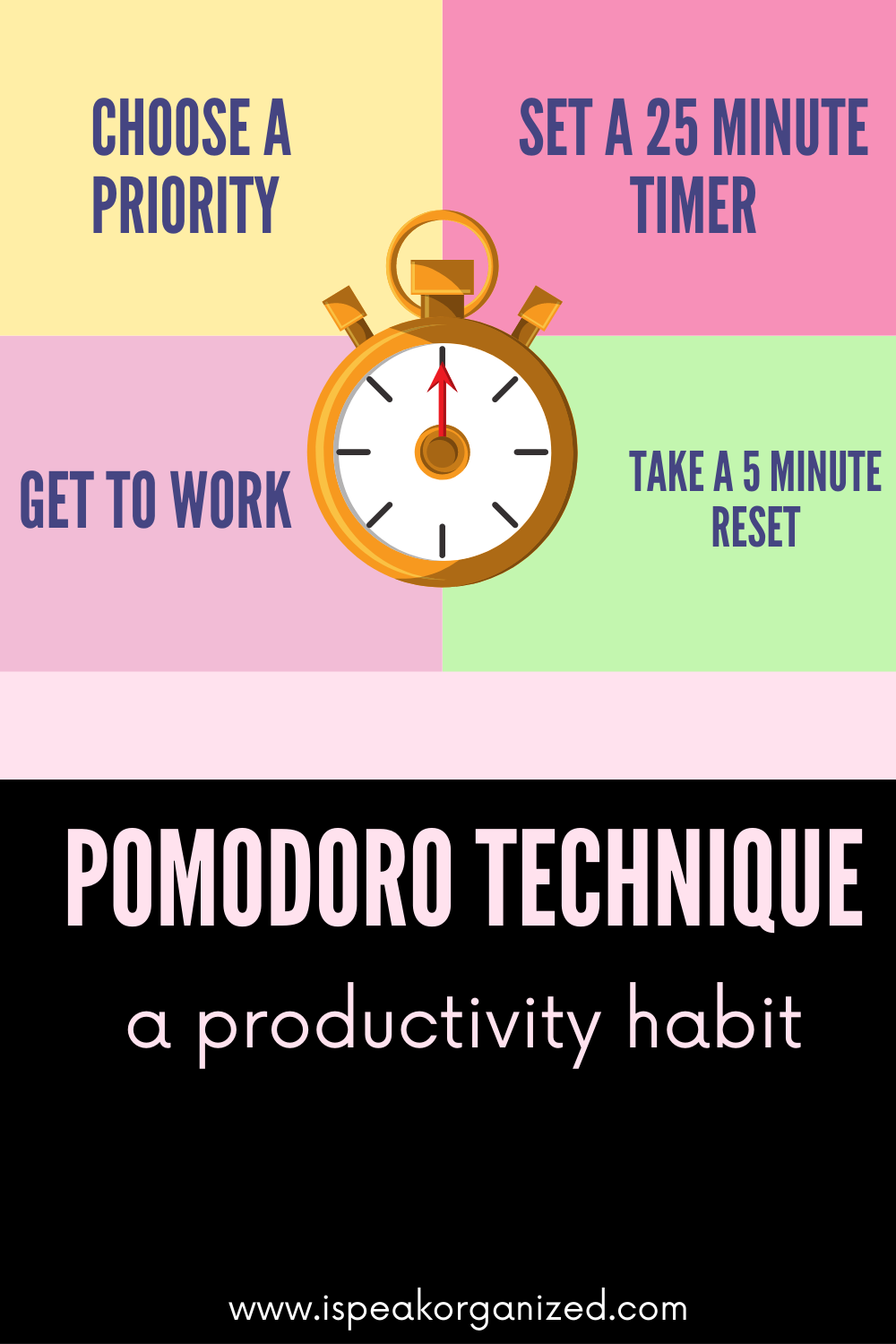6 Tips to Improve Your Time Management Using the Pomodoro Technique
5 minute read.
+ Affiliate Disclosure
This post contains affiliate links. All that means is I’ve provided some product suggestions that I get a commission for should you click on them and make a purchase. I only suggest products I use and love that are directly related to the content in this post. Thank you for your support! View terms for more information.
Watch the video.
What you’ll get from this article | Quick navigation links
What is the pomodoro technique?
What do time management, tomatoes, and the 1980s have in common? The answer is the pomodoro technique. This concept is, without question, the household name of productivity hacks. I am certain that you’re more capable than you give yourself credit for and the pomodoro technique will prove it to you.
Invented in the late 1980s to early 90s by Francesco Cirillo when he was a university student, the pomodoro technique improves the lives of millions of self-imposed taskmasters. The concept is simple -
Set a 25-minute timer
Get to work
Take a five-minute break
Repeat the process four times
Take a longer 15-20 minute break
The tomato originally came into play because Mr. Cirillo used a tomato-shaped timer to track his minutes. The task increments are commonly referred to as “pomodoros.”
Cool side note-
Francesco Cirio (not to be confused with our friend Mr. Cirillo) was a 19th-century businessman from Italy credited with developing the “appertization” technique. He used this canning system to preserve vegetables, specifically... tomatoes. I think that’s a neat coincidence.
The psychology of why this technique is so effective and scenarios to use it in.
The primary reason people love the pomodoro technique so much is because it shows results immediately without a ton of effort. The beauty really is in the simplicity. You can start with the basic timer routine and get more of a task completed than perhaps you might otherwise.
Why is this?
Let me give you an example. I’ve been a dance educator for 17+ years and I've used timers as an effective motivator frequently. You wouldn’t believe how fast a group of 10-year-olds move when they know that only 10 seconds stand between them getting in formation and doing 50 pushups. When you’re under a time constraint, you are more motivated to focus and get as much done as possible. Most humans are low key adrenaline junkies and every game show host knows it. The “lightning round” is so enthralling and usually comes with the biggest, shiniest prize.
However, milking your adrenal gland every time you need to get important things done isn’t a sustainable use of this method. The timer is merely the initial phase and we need to dig deeper for true benefit. Mr. Cirillo wrote an entire book about it and you can get it for free on Audible. I super recommend it.
6 tips to optimize the pomodoro technique to become a bonafide productivity boss.
Tip #1. Understand the practice of monotasking.
In contrast to multitasking, monotasking (sometimes referred to as single-tasking) is the act of focusing on executing a single thing rather than forcing our brains to task switch. Giving attention to different things simultaneously isn’t possible. Instead, we are asking our brains to rapidly switch between ideas, which is difficult in interminable stretches. Multitasking slows us down and renders us less productive.
As its number one principle, the pomodoro technique implores us to give our undivided attention to a task. The responsibility itself doesn’t need to be large or small, monumental, or inconsequential. We just need to give it our all.
I find this idea useful for completing big, multi-step work projects and simple household chores I loathe (like dusting, UGH...). Having a firm start and end time to certain things forces me to devote my attention and push through til the timer goes off.
Tip #2. Commit to pushing through, uninterrupted as best you can.
25 minutes isn’t that long and most emails, phone calls, nagging kids, and responses to Facebook comments can wait 25 minutes. There are exceptions like getting called into an urgent meeting or an emergency with a child etc. Use your best judgment. The best thing to do is prepare time in your day for focus when you know you aren’t likely to be interrupted.
Tip #3. Acknowledge distractions.
Similarly to silent meditation, when you encounter a wandering thought, acknowledge it and bring your focus back to your meditation. Apply this by writing the distraction on scratch paper. When you’re done, you can see how many distractions you encountered and slowly work towards fewer as you practice. Writing them down is important to track your baseline ability to focus. I’ve included a free distraction tracker printable here.
Tip # 4. Track your progress.
If you have a to-do list going, be sure to check things off as you complete them within the 25 minutes. Cirillo suggests creating a timer checklist and tracking how many 25 minutes sessions you finish. This is key to true improvement in time management because it shows how long you take to complete a project.
For example, let’s say you’re creating a sales presentation for a client. During your work sessions throughout the week, you go through 12 pomodoros. That’s 6 hours if you include your 5 minute mini breaks. If similar sales presentations are part of your typical workflow, you know that you take between 5-6 hours to complete a presentation. Plan your time accordingly when creating your next one. How cool is that?
Tip # 5. Take those breaks seriously.
Think about it. Would you run consecutive sprints back to back with no rest? Not if you were smart about it. Your brain isn’t a muscle, but treat it like one, which includes a proper break. The catch is to step away from your screens. Try to avoid hopping on your phone. Instead, get up and stretch your legs, grab some water, chat with a friend, etc. Doing this consistently cuts down on that feeling of mental fatigue.
Once you’ve completed four pomodoros remember to take a longer break. I call this the “marinating period.” Allow your brain time to marinate on the task you’re doing and let your mind absorb the information to process. This is the same reason students are told to sleep instead of staying up late cramming for tests. Rest better equips them to retain information rather than trying to learn it throughout mental lethargy.
A bonus to scheduled break time is the elimination of guilt. Enjoy your break rather than feeling lazy or like you should be working. The more you practice the exchange between focus and rest, the more adept you become.
Tip # 6. Define your objectives.
While 25 minutes is the recommended block of time, you can experiment with different parameters to maximize effectiveness. For instance, maybe you need to get your house cleaned up in 15 minutes before everyone gets home. Use a timer to speed clean and focus on the high-traffic areas as much as possible.
Here’s another example. Perhaps you need to spend 10 of your 25 minutes reviewing your work from yesterday to maximize the following 15 minutes. Use your project records to determine if you need to adjust the time you spend on a particular aspect of a project. Let’s say your child is working on their 7th-grade science experiment and you notice they spend several pomodoros researching. Encourage them to devote more time to the experiment phase or the recording phase, etc. See how these adjustments in focus affect the outcome of their project.
Final thoughts
Find tasks you need help to complete and give this technique a try. If it’s effective for you, I’d encourage you to snag the book and take it to the next level. Remember, you’re more capable than you give yourself credit for. The pomodoro technique will prove it to you.
Yours in Productivity,
Melanie
Did you find this article helpful? Check out Francesco Cirillo’s book - The Pomodoro Technique.
Be sure to read “What Procrastination Really Is and How to Overcome It | Eating Your Frog“ for more inspiration on you journey to becoming a productivity boss.




